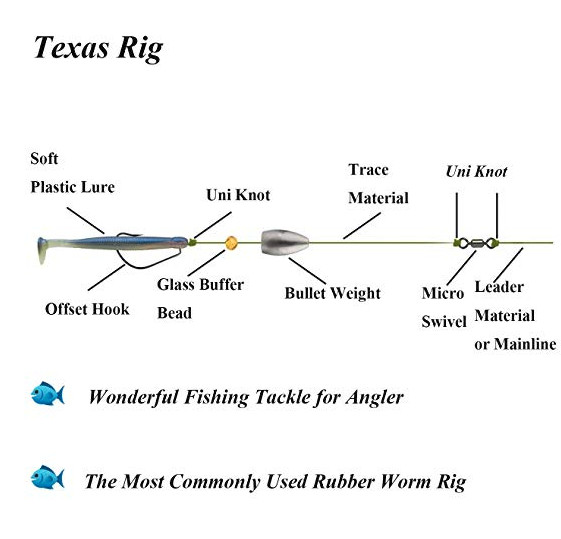Texas Rig for Bass
Texas rig fishing is more than a simple loop. In the world of fishing there are few skills more important than how to tie a hook to a line. After all, if the hook slips off a line or out of a lure, the fish gets away. Despite the importance of this facet, many anglers don’t know how to tie a hook, let alone set a line for Texas rig fishing.
Types of Fishing Hook Knots
There are several types of fishing hook knots, however, there are the top 5 fishing knots that everyone heading to the water should know.
They are as follows:
- Improved Clinch
- Palomar
- Turtle
- Double Surgeon’s Loop
- Blood Knot
How Do You Tie a Fishing Knot?
The strongest fishing knots, like any nautical knot, are designed for different uses. Knowing each one and what it is used for is invaluable for beginners and experienced anglers alike.
The most commonly used knot for tying a hook to a line is the improved clinch. A fairly simple knot, this is one of the best fishing knots for monofilament lines.
In order to tie an Improved Clinch:
- Thread the line through the eye of the hook, then make 5-7 wraps around the line with the loose end.
- Thread the loose end of the line through the loop closest to the eye, then back around inside the loose section of line.
- Pull both ends of the line until tight.
- Trim the loose end of the line, if necessary.
When a stronger hook attachment is needed with no loose ends, try the Palomar knot.
- Double the line to make a loop, then push the loop through the eye of the hook.
- Tie a loose overhand knot.
- Pass the loop around the end of the hook.
- Pull on the line to tighten.
- Trim the loose end of the line, if necessary.
For a small, light hook, the Turtle Knot is a go-to friend.
- Run the line through the eye of the hook, then tie a loose, double overhand knot in the end of the line.
- Pass the open loop over the hook and tighten the whole thing so that the loop tightens around the eye.
Line-to-line Knots and Rig Knots
Every angler has had the frustration of a snapped line. The problem is reattaching the line without creating a stiff knot that can snarl the reel and foul the return.
After trying a variety of knots, many simply throw away yards of line in frustration. Here at the Rusty Angler, however, we have the answer. The blood knot.
The blood knot is simple to tie and won’t work free or snarl the line.
- Line up the ends of each line together for several inches, then wrap the first line around the second at least five times.
- Wrap the second around the first at least five times, and bring both loose ends back to the middle between the two lines.
- Pull tight on each line until the knot is snug.
Lastly, the Loop Knot is a go-to staple of the mariner’s world. This is a versatile knot used for everything from hooks and lines to holding bait lines. Of all these knots, the strongest loop knot is the double surgeon’s loop.
- Fold over the end of the line to make a double line, then tie a single overhand knot.
- Pass the loop through the hole in the overhand knot one more time.
- Moisten the knot and tighten.
Texas Rig Fishing – If it’s from Texas it must mean Big Fish!
Now that the hook is attached to the line, it’s time to rig some bait. One of the most common rigs, especially for bass, is the Texas rig setup.
The Texas rig for bass continues to be the best match for a variety of soft plastic baits including plastic worms, creature and beaver baits, tubes, craws and Senkos.
When a soft plastic lure is rigged straight on a hook, the Texas rig creates a streamlined and weedless bait that can be presented effectively into the thickest cover.
The best knot for bass fishing is the improved clinch and is, by far, the best knot for a Texas rig. Learn more about other types of bass lures, too.
How to Tie a Texas rig
Any new angler planning on doing some Texas rig fishing needs to realize that tying up a Texas rig for bass is no big task. Part of the popularity of Texas rig fishing is the ease of setting it up.
The Texas rig consists of 4 basic elements:
- A soft plastic lure
- A bullet-shaped sinker
- A pegging device
- A hook.
The hook should be a 3/0 straight shank for plastic lizards, Senkos, and six-inch plastic worms. Use a 4/0 straight shank for larger plastic worms, beaver baits and craws.
Match the hook with a bullet-shape slip sinker. The weight should be determined by rate of fall, depth of the fish, and thickness of cover.
Pegging the weight with a piece of rubber band, bobber stop or commercial pegging devices keeps the slip sinker close to the hook and lure. This is crucial when setting a Texas rig for bass because the weight stays close to the lure and helps pull it through thick weeds and cover.
Get great gear without emptying that wallet.
Here at Rusty Angler, we believe in fishing giveaways, fishing sweepstakes, and fishing promotions. While a fishing giveaway might land some free swag, fishing sweeps are a great way to enter competitions for extra gear.
That being said, one of the best areas to investigate is the world of fishing promotions. Companies have fishing promotions all the time specifically to attract new buyers or to highlight new products.
Why is that important? Well, that means gear at either greatly reduced prices or even free.
In addition, a good fishing contest allows anglers to win free gear just by doing what is already being done – catching fish.
So grab some gear, grab a great Rusty Angler deal, and head to the water and try some great Texas rig fishing knots!







